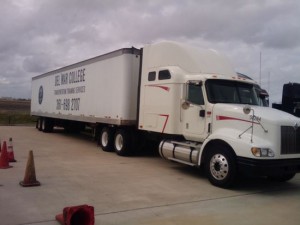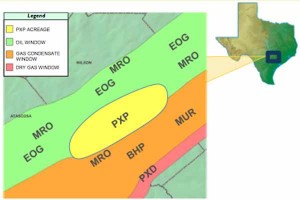LNG powered frack pumps were used to complete an Eagle Ford well in late 2012. We sat down with Ferus' LNG rep Jed Tallman to learn more. This was the first time LNG has ever been used to fuel pumps fracking a well. Field gas has been used by Schlumberger in the Horn River Basin of Canada, but LNG has never been used before.
Ferus is an oilfield service company that supplies cryogenic liquids as part of its offering. The company worked with Baker Hughes to test natural gas conversion technology and yard tested 10 Cummins QSK50 powered pumps. After a successful test, the companies took the pumps into the field to complete an Eagle Ford well south of Pearsall.
Diesel fuel was used as the spark for combustion and LNG was regassed and brought in through the air intake.
Mr. Tallman stated, "This particular technology can achieve diesel substitution rates of 40-65%. An average of 50% substitution is expected.""
Only 6 LNG powered pumps were used on this particular job, but ten will be tested soon. A real determination of savings will be made when the LNG pumps are being fully utilized.
In simple economic terms, vaporized LNG is 20-40% cheaper than diesel fuel. Ifyou can substitute half that cost, you can save 10-20% on fuel costs alone. Build pumps fully powered by LNG and you might save 40%. Consider the average Eagle Ford well can consume as much as 25,000 gallons of diesel and the economics become attractive.
LNG Provides Environmental Benefits
There is also an environmental benefit to using LNG over diesel. Emissions for natural gas vs. diesel can drop as much as 30% for CO2, 75% drop for NOx, 90% drop in particulates, and a 99% drop is SOx emissions.
More LNG Powered Frack Jobs Are Coming
“Ferus is building one 50,000 gallon per day LNG plant in Western Canada and has plans for three more, each of which will have capacity for 87,000 to 100,000 gallons per day, consuming 8.5 mmbtu’s/day.”
Ferus is building one 50,000 gallon per day LNG plant in Western Canada and has plans for three more, each of which will have capacity for 87,000 to 100,000 gallons per day, consuming 8.5 mmbtu’s/day. Ferus is currently looking at areas of high demand and expects the Eagle Ford to top that list. The company committed to develop the plants a couple of years ago, so everything is in place to have a plant up and running in as little as 18 months.
This won't be the last time you hear about LNG being used in frack pumps. Apache will complete a well with 12 LNG powered frack pumps in January of 2013. The effort will be in partnership with Schlumberger and Halliburton. Apache expects fuel cost to fall from a little more than $120,000 to less than $75,000 when utilizing a duel fuel approach similar to that implemented by Baker Hughes and Ferus.
The real hope is to one day fuel the pumps with gas source directly from the field. If field gas were to replace diesel, the industry could save more than $1.5 billion per year. Sounds to me like Ferus should get to work on a new plant in South Texas.






